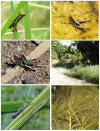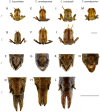Climate and soil type together explain the distribution of microendemic species in a biodiversity hotspot
- PMID: 24367480
- PMCID: PMC3867321
- DOI: 10.1371/journal.pone.0080811
Climate and soil type together explain the distribution of microendemic species in a biodiversity hotspot
Abstract
The grasshopper genus Caledonula, endemic to New Caledonia, was studied to understand the evolution of species distributions in relation to climate and soil types. Based on a comprehensive sampling of 80 locations throughout the island, the genus was represented by five species, four of which are new to science, of which three are described here. All the species have limited distributions in New Caledonia. Bioclimatic niche modelling shows that all the species were found in association with a wet climate and reduced seasonality, explaining their restriction to the southern half of the island. The results suggest that the genus was ancestrally constrained by seasonality. A molecular phylogeny was reconstructed using two mitochondrial and two nuclear markers. The partially resolved tree showed monophyly of the species found on metalliferous soils, and molecular dating indicated a rather recent origin for the genus. Adaptation to metalliferous soils is suggested by both morphological changes and radiation on these soils. The genus Caledonula is therefore a good model to understand the origin of microendemism in the context of recent and mixed influences of climate and soil type.
Conflict of interest statement
Figures







Similar articles
-
Old Lineage on an Old Island: Pixibinthus, a New Cricket Genus Endemic to New Caledonia Shed Light on Gryllid Diversification in a Hotspot of Biodiversity.PLoS One. 2016 Mar 30;11(3):e0150920. doi: 10.1371/journal.pone.0150920. eCollection 2016. PLoS One. 2016. PMID: 27027632 Free PMC article.
-
Secondary sympatry caused by range expansion informs on the dynamics of microendemism in a biodiversity hotspot.PLoS One. 2012;7(11):e48047. doi: 10.1371/journal.pone.0048047. Epub 2012 Nov 6. PLoS One. 2012. PMID: 23139758 Free PMC article.
-
Reticulate evolution on a mosaic of soils: diversification of the New Caledonian endemic genus Codia (Cunoniaceae).Mol Ecol. 2009 May;18(10):2263-75. doi: 10.1111/j.1365-294X.2009.04178.x. Epub 2009 Apr 14. Mol Ecol. 2009. PMID: 19389179
-
New Caledonia: a very old Darwinian island?Philos Trans R Soc Lond B Biol Sci. 2008 Oct 27;363(1508):3309-17. doi: 10.1098/rstb.2008.0122. Philos Trans R Soc Lond B Biol Sci. 2008. PMID: 18765357 Free PMC article. Review.
-
Predicting the distribution of Ixodes ricinus and Dermacentor reticulatus in Europe: a comparison of climate niche modelling approaches.Parasit Vectors. 2023 Oct 25;16(1):384. doi: 10.1186/s13071-023-05959-y. Parasit Vectors. 2023. PMID: 37880680 Free PMC article. Review.
Cited by
-
Old Lineage on an Old Island: Pixibinthus, a New Cricket Genus Endemic to New Caledonia Shed Light on Gryllid Diversification in a Hotspot of Biodiversity.PLoS One. 2016 Mar 30;11(3):e0150920. doi: 10.1371/journal.pone.0150920. eCollection 2016. PLoS One. 2016. PMID: 27027632 Free PMC article.
-
Outstanding micro-endemism in New Caledonia: More than one out of ten animal species have a very restricted distribution range.PLoS One. 2017 Jul 20;12(7):e0181437. doi: 10.1371/journal.pone.0181437. eCollection 2017. PLoS One. 2017. PMID: 28727847 Free PMC article.
-
Analysis of intrinsic evolutionary factors leading to microendemic distributions in New Caledonian leaf beetles.Sci Rep. 2023 Apr 27;13(1):6909. doi: 10.1038/s41598-023-34104-z. Sci Rep. 2023. PMID: 37106022 Free PMC article.
-
Evolution of Plant Architecture, Functional Diversification and Divergent Evolution in the Genus Atractocarpus (Rubiaceae) for New Caledonia.Front Plant Sci. 2018 Dec 4;9:1775. doi: 10.3389/fpls.2018.01775. eCollection 2018. Front Plant Sci. 2018. PMID: 30564258 Free PMC article.
-
Climate change and alpine-adapted insects: modelling environmental envelopes of a grasshopper radiation.R Soc Open Sci. 2022 Mar 2;9(3):211596. doi: 10.1098/rsos.211596. eCollection 2022 Mar. R Soc Open Sci. 2022. PMID: 35316945 Free PMC article.
References
-
- Myers N, Mittermeier RA, Mittermeier CG, da Fonseca GAB, Kent J (2000) Biodiversity hotspots for conservation priorities. Nature 403: 853–858. - PubMed
-
- Raven PH, Axelrod DI (1972) Plate Tectonics and Australasian Paleobiogeography. Science 176: 1379–&. - PubMed
-
- Morat P, Jaffré T, Veillon JM, Mackee HS (1986) Affinités floristiques et considérations sur l’origine des maquis miniers de la Nouvelle-Calédonie. Adansonia 2: 133–182.
-
- Jaffré T (1992) Floristic and ecological diversity of the vegetation on ultramafic rocks in New Caledonia. In: Baker AJM, Proctor J, Reeves RD, editors. The Vegetation of Ultramafic (Serpentine) Soils. Andover: Intercept Ltd. pp. 101–107.
-
- Chazeau J (1993) Research on New Caledonian Terrestrial Fauna: Achievements and Prospects. Biodiversity Letters 1: 123–129.
Publication types
MeSH terms
Substances
LinkOut - more resources
Full Text Sources
Other Literature Sources
Molecular Biology Databases

